|
Endowed with abundant scenic beauty:
Uva province progress at a pace
By P. Krishnaswamy
|
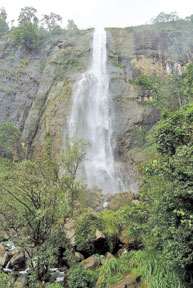
The Diyaluma Falls |
The Uva province, primarily an agricultural and plantation region,
with many places of historical and architectural value, places of
religious importance, several picturesque waterfalls, beautiful
landscape, and diverse climates was lagging behind, for many decades
since Independence, in relation to economic and social standards but has
now recorded a marked progress in all development spheres thanks to the
UPFA administration and its far-reaching development programs
implemented in the province.
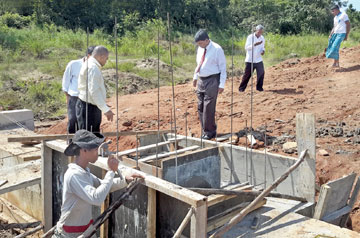
Home garden of a family in the Moneragala district under the
Home Garden for Rural Families project |
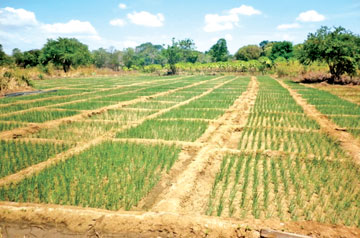 |
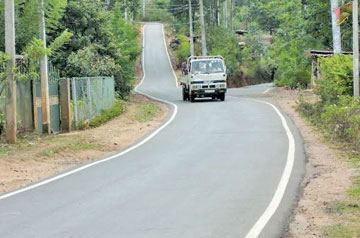
The Aluthwela-Galedenna Road after completion |

A milk collecting centre in a rural area in the Moneragala
district, under incentives provided by the Government for dairy
farming |
 |
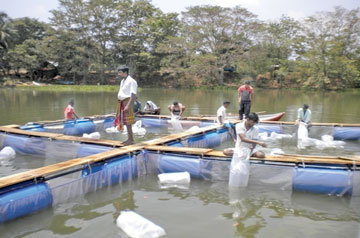
An aquaculture project |
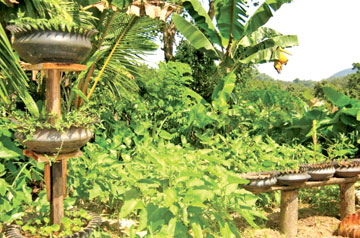 |
The Uma Oya Multipurpose Project in the province tops the list of the
multifarious development projects launched by the Government for the
accelerated and sustainable development of the province where the
below-poverty-line average remained high compared to the other provinces
while water scarcity for cultivation also remained persistent. The
project, anticipated to be commissioned at the end of 2016. will come as
a boon to the agricultural families while also addressing the water
scarcity problem of people in many areas of the province.
It is projected that 25,000 acres of paddy lands in the Uva Wellassa
and the Ruhuna will come under irrigation , both during the Yala and
Maha seasons on completion of the Uma Oya project. Another 12,000 acres
of arable paddy lands that remains uncultivated due to want of
irrigation facilities will also be brought under cultivation, according
to government sources. The project will provide water to the Hambantota
Port, Mattala Mahinda Rajapaksa International Airport and the Hambantota
Industrial zone. The entire project aims to solve the drinking water
problems in the Uva Wellassa and the Ruhuna while feeding the
Lunugamwehera Reservoir. The 120MW power to be generated under the
project will be added to the national grid with arrangements for
providing the power requirement of the province.
Maximum infrastructure facilities to expand the area of arable lands
for paddy cultivation have already been initiated, secretariat sources
said. Under the different irrigation-oriented programs, which include
reconstruction and renovation of tanks, reservoirs, canals and anicuts,
water flows to more areas creating more arable lands. Twenty such
projects were implemented at the inception under 'Gama Neguma' at a cost
of Rs. 17 Mn. The community contribution under the program was estimated
to value of Rs. 7 Mn.
Badulla district records an average of 126,000 metric tonnes of paddy
harvest. In the entire district a variety of vegetables are cultivated
in approximately 15,620 hectares and perennial crops are cultivated in
an area of 10,098 ha in extent. In specific seasons, potatoes are
cultivated in 2000 ha, beans in 2200 ha, tomato in 1000 ha, cabbage in
700 ha, carrot in 400 ha, and radish in 250 ha. On an average,
vegetables are grown in two seasons depending on favourable weather
conditions. Electricity has been provided to a majority of the rural
population in the Moneragala and Badulla districts.
The province which is a treasure house of breathtaking waterfalls
such as the Dunhinda, Diyaluma and Ravana falls, the Yala National Park,
the Gal Oya National park, the perennial Mahaveli Ganga and Menik Ganga,
the Senanayake Samudra and Maduru Oya Reservoirs, the Kataragama temple,
the Mahiyangana Rajamaha Vihara and the Muthiyangama Raja Maha Vihara is
fast transforming into an economic nerve centre of the country, under
the accelerated development programs of the Government.
The Economic Development Ministry has allocated Rs 2,657 million to
develop Badulla District under the House-to-House, Village-to-Village
National Economic Development Plan. The Badulla district program will
cover 567 Grama Niladari divisions in the 15 Divisional Secretariat
areas of Badulla, Haputale, Bandarawela, Uva- Paranagama, Welimada,
Mahiyanganaya, Passara and , Hali Ela. The beneficiaries will be 811,758
of 239,463 families in the Badulla district. The number of 'Divi Neguma'
beneficiaries is 59,273.
In the current year, until July 24, funds were allocated for
different programs such as: one program for one village, Gama Neguma
special program , Divi Neguma program, Pura Neguma program, minor
irrigation for uncultivated lands program, rural roads and bridges
program, sanitary program for rural schools, forest conservation program
and programs under the decentralised budget allocations. While the total
amount allocated for these programs until July 24 is well over Rs. 2
billion, similar amounts were allocated for the programs every year from
the year 2009 until end of 2013, according to the Badulla District
Secretariat sources. In addition 10 rural bridges in the Badulla
district have already been completed under the island-wide program to
build 210 rural bridges. Work on additional number of bridges in the
Badulla district is scheduled to begin under the program to build 1,000
bridges throughout the country before the end of 2014, as proposed under
this year's Budget.
The Economic Development Ministry has allocated Rs. 1,723 million for
developing the Moneragala district under the House-to-House,
Village-to-Village National Economic Development Plan. The program will
cover 319 Grama Niladari Divisions in 11 Divisional Secretariat
divisions. The beneficiaries will be 448,142 of 132,370 families in the
District.
According to Moneragala District Secretary (GA), 356 villages will
benefit from the program which is being launched under the direction of
Economic Development Minister Basil Rajapaksa on President Mahinda
Rajapaksa's advice. Under the program Rs. 40 Mn is for sanitary
facilities and other health facilities in schools, Rs.403 Mn for Gama
Neguma, Rs. 90 Mn for wildlife and nature conservation, Rs.90 Mn for
Divi Neguma livelihood development, Rs. 211 Mn for the repair of small
irrigation channels and Rs.40 Mn for internal rural road development.
Also allocated for these purposes is Rs. 100 Mn under implementation of
proposals by people representatives and Rs. 25 Mn under the
decentralized budget allocations.
According to the District Secretariat, Moneragala, Rs.42.56 Mn has
been allocated for the years 2010-2013, under one of the several Devi
Neguma Development program in the agricultural sector. Rs.7.6 Mn was
allocated for poultry and animal husbandry development and Rs.10.42 Mn
was allocated for development of the industrial development sector.
Rs.515.937 Mn was allocated on 1056 projects under the 'Jathika Savaya'
development program, according to the sources.
In the years 2010 - 2012 Rs.25.16 Mn was allocated for 63 projects on
water supply. Rs. 25.16 Mn was allocated in the years 2010-2012 for 63
minor water supply projects in the district. Under the 'Jathika Savaya'
Gama Neguma program an amount of Rs. 32.89 Mn was allocated for 65
projects, under the decentralised budget allocations, according to the
sources.
For the district an amount of Rs.74.39 Mn was allocated in the years
2010-2013 benefiting 697,391 families. Rs.35.03 Mn was allocated in the
years 2012-2013 on 78 projects benefiting 15,856 school children and the
Samurdhi Bank loans in the years 2010-2012 reached Rs.4534.6 Mn
benefiting 300,034 families. The estimated cost for the construction of
a secretariat complex at Moneragala in the years 2014 and 2015 is Rs.467
Mn and the estimated cost for establishing an economic centre during the
two years is Rs.500 Mn. according to the sources. |

